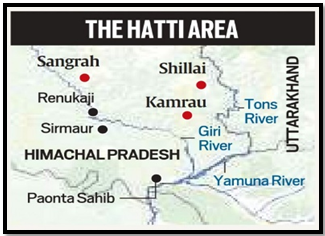INCLUSION OF HATTEE COMMUNITY IN SCHEDULED TRIBES LIST
Why in the News?
- Following President Droupadi Murmu’s notification, Himachal Pradesh’s State government issues directions for the inclusion of the Hattee community in the Scheduled Tribes (ST) list.
The Issue:
- The term ‘Hattee’ was previously associated with Scheduled Castes, leading to uncertainty about their inclusion in the ST list and classification of Hattees from the Trans-Giri area of Sirmour district.
Source: Indian Express
About Hattee Community
- Background: Originating from the tradition of selling produce at local markets called ‘haat,’ the Hattees are a closely-knit community.
- Geographical Presence: The Hattee homeland extends across the Himachal-Uttarakhand border, situated in the Giri and Tons river basin, both Yamuna tributaries.
- Historical and Administrative Overview: Once part of the royal estate of Sirmaur, the Hattees in the trans-Giri area (Himachal Pradesh) and Jaunsar Bawar (Uttarakhand) separated in 1814.
- Social Structure and Governance:
- Governed by the ‘khumbli,’ a traditional council, the Hattees’ social structure resembles the ‘khaps’ in Haryana.
- Inter-caste marriages are traditionally discouraged.
- Demographics: As per the 2011 Census, the tribal population in Himachal Pradesh, including the Hattee community, constitutes 5.7% of the total state population (3,92,126 individuals).

 Source: Indian Express
Source: Indian Express

